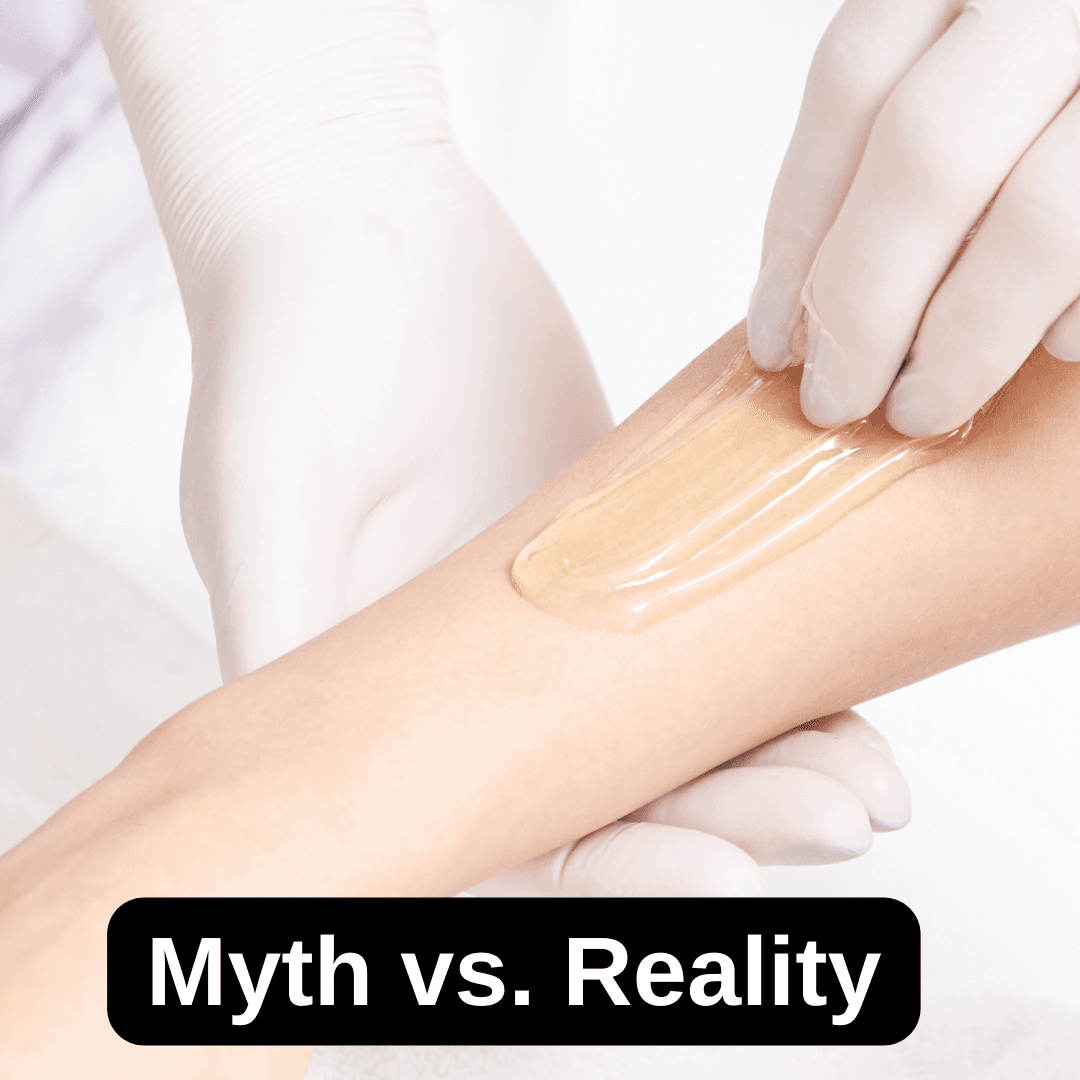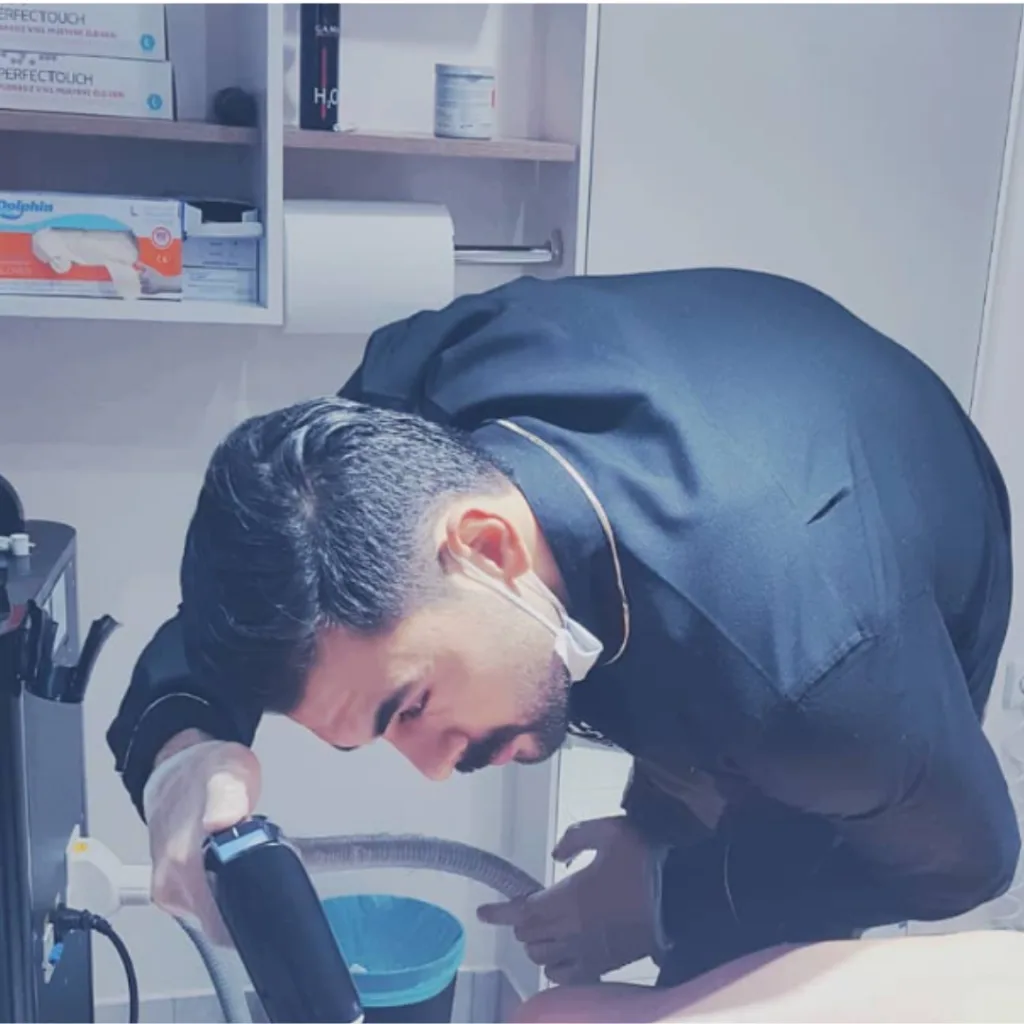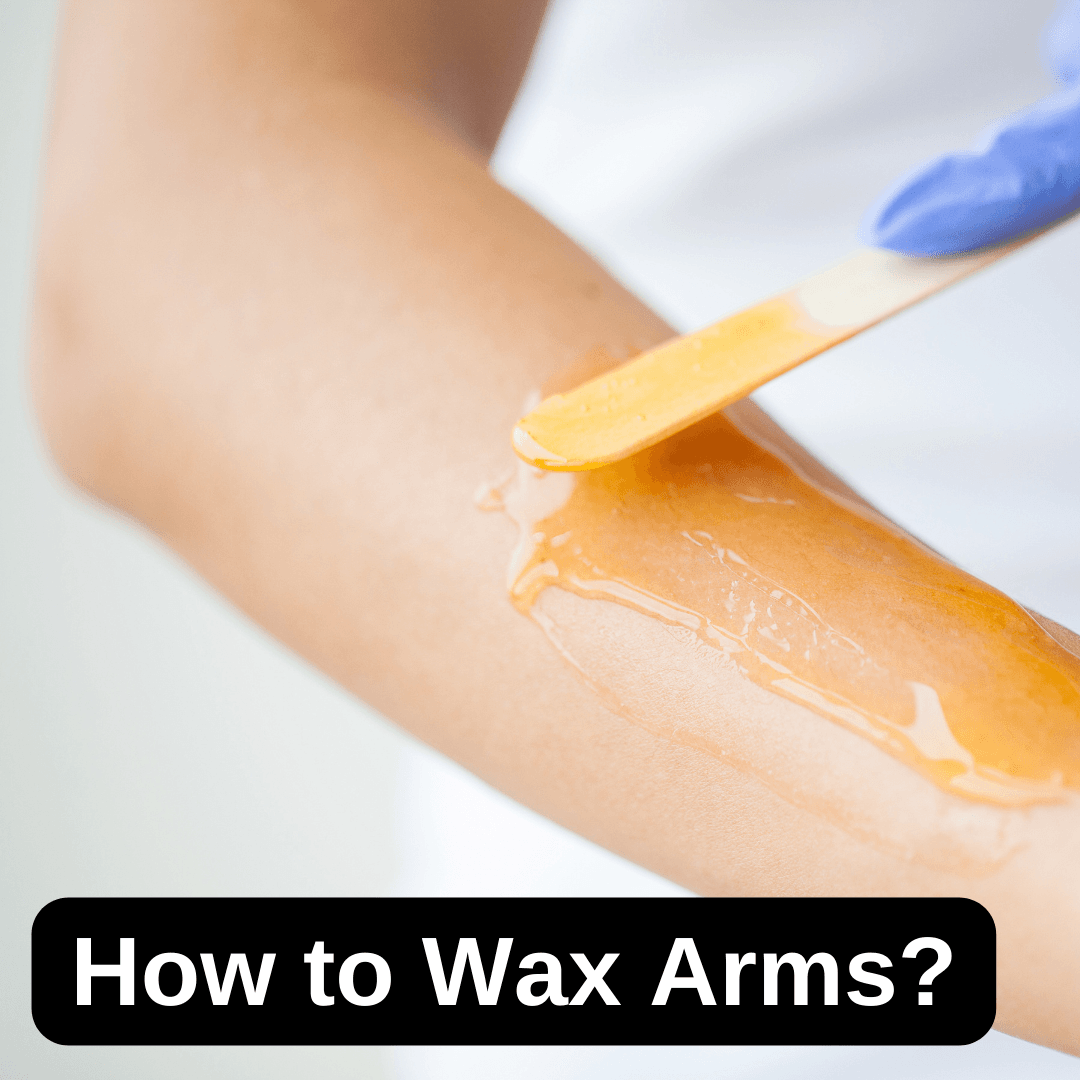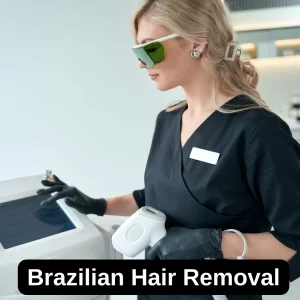Waxing is one of the most effective methods for achieving smooth, hair-free arms. Unlike shaving, which only cuts hair at the surface, waxing removes hair from the root, leading to longer-lasting results and softer regrowth. But how do you properly wax your arms without irritation, pain, or ingrown hairs? In this guide, we’ll cover everything you need to know—from prepping your skin to post-wax care—so you can get salon-quality results at home. Whether you’re wondering how often to wax, whether it’s painful, or if waxing makes hair grow back thicker, we’ve got you covered with expert-backed answers.
How to Wax Arms Properly?
Waxing your arms is an effective way to achieve smooth skin for weeks. Follow these steps for the best results:
Step-by-Step Guide to Waxing Arms
- Prepare Your Skin: Exfoliate 24 hours before waxing to remove dead skin cells and reduce the risk of ingrown hairs.
- Choose the Right Wax: Hard wax is recommended for sensitive skin, while soft wax works well for fine hair.
- Cleanse the Area: Use a gentle cleanser to remove oils and dirt.
- Apply Wax in the Direction of Hair Growth: This ensures the wax adheres properly to the hair.
- Remove Wax Quickly: Pull the wax strip against the hair growth in a swift motion.
- Soothe the Skin: Apply a calming lotion or aloe vera gel to reduce irritation.
Is It a Good Idea to Wax Your Arms?
Yes, waxing your arms is a great choice for long-lasting smoothness and finer regrowth over time. Unlike shaving, which only cuts hair at the surface, waxing removes hair from the root, delaying regrowth for 3 to 6 weeks. Regular waxing can also lead to thinner, softer hair over time, reducing the need for frequent maintenance. Additionally, waxing acts as a natural exfoliation method by removing dead skin cells along with the hair, resulting in brighter, smoother skin. Many people prefer arm waxing for its long-lasting effects, fewer ingrown hairs, and the convenience of avoiding daily shaving. If you’re looking for a low-maintenance hair removal solution, waxing your arms can be a highly effective and worthwhile option. For those looking for permanent hair reduction, some people consider alternatives like laser hair removal, which can significantly slow hair regrowth over time. If you’re unsure whether facial waxing is safe or suitable for your skin type, this detailed guide breaks down the pros and cons: https://www.epilationworld.com/is-it-bad-to-wax-your-face/
How Painful Is Waxing Arms?
Waxing your arms is generally less painful than waxing areas like the bikini line or underarms because the skin on the arms is less sensitive. However, the level of pain varies depending on individual pain tolerance, hair thickness, and waxing technique. People with coarser or denser hair may experience slightly more discomfort than those with finer hair.
To minimize pain, consider taking a warm shower beforehand to open up the pores and soften the hair, making removal easier. Applying a numbing cream 30 minutes before waxing can also help dull the sensation. Additionally, holding the skin taut while pulling the wax strip off quickly can reduce discomfort. Most people find that the pain decreases after the first few sessions, as hair grows back thinner and weaker over time.
If you’re concerned about pain, starting with a professional waxing session can help ensure proper technique and minimize discomfort. Those with low pain tolerance might explore less painful alternatives such as laser waxing, which combines light and heat to weaken hair growth while reducing discomfort.
What Do You Put on Your Arms Before Waxing?
Before waxing your arms, it’s essential to prepare your skin properly to ensure the wax adheres effectively and removes hair without irritation. The best pre-waxing step is to apply a light layer of baby powder or cornstarch to the skin. These help absorb excess moisture, sweat, and oils, allowing the wax to grip the hair more effectively while reducing the risk of irritation.
What to Avoid Before Waxing Your Arms
- Lotions, creams, or oils – These create a barrier that prevents the wax from sticking properly, leading to patchy hair removal.
- Heavy moisturizers – Hydrated skin is essential, but apply moisturizers at least 24 hours before waxing, not right before the session.
- Excessive sweating – If your skin is damp, the wax may not adhere well, causing breakage instead of clean hair removal.
For smoother waxing and less pain, cleanse your arms with a gentle, oil-free cleanser before applying powder. This ensures the skin is free from dirt and natural oils, helping the wax grip hair at the root for better, longer-lasting results. For those considering permanent solutions, understanding how laser hair removal works can help you decide if waxing or another method is right for you.
Dermatologists recommend using talc-free powders before waxing to absorb excess moisture. The U.S. Food and Drug Administration (FDA) highlights the importance of avoiding certain skincare products before hair removal treatments.”
Link: https://www.fda.gov/cosmetics/cosmetic-products/hair-removal-products-fda-answers-your-questions

Will My Arm Hair Grow Back Thicker If I Wax It?
No, waxing does not make arm hair grow back thicker, darker, or coarser. In fact, repeated waxing weakens the hair follicles over time, leading to finer, softer, and sparser regrowth. This is because waxing removes hair from the root, disrupting the natural growth cycle and preventing hair from regrowing as thick as before.
Why Doesn’t Waxing Make Hair Thicker?
- Hair Regrowth Comes in Stages: After waxing, hair regrows in different cycles, making it appear less dense.
- Follicle Weakening: With regular waxing, hair follicles shrink, producing thinner and finer hair over time.
- No Change in Hair Density: Waxing does not alter the number of hair follicles, meaning new growth remains the same or even reduces over time.
Myth vs. Reality
Myth: Waxing makes hair grow back thicker and darker.
Reality: Over time, waxing actually results in less noticeable regrowth. Many people who wax regularly experience patchier and lighter hair regrowth compared to shaving, which cuts the hair at the surface and gives the illusion of thickness.
For permanent reduction, consistent waxing can thin out hair significantly, making the process even easier and less painful over time. If you’re curious about permanent hair removal methods, check out: https://www.epilationworld.com/how-many-sessions-for-electrolysis/
Should I Shower After Waxing My Arms?
Yes, you can shower after waxing your arms, but it’s important to avoid hot water and harsh cleansing products for at least 24 hours. Freshly waxed skin is more sensitive, and exposure to heat, steam, or scrubbing can cause irritation, redness, or even breakouts.
How to Shower After Waxing for Best Results
- Use lukewarm water instead of hot water to prevent irritation.
- Skip harsh soaps and exfoliants; use a mild, fragrance-free cleanser.
- Avoid scrubbing and pat the skin dry with a soft towel.
- Apply a lightweight, fragrance-free moisturizer such as aloe vera to soothe the skin.
What to Avoid After Waxing Your Arms
- Hot showers, saunas, or steam rooms, as heat can cause inflammation and prolong redness.
- Exfoliating immediately; wait at least 48 hours before using a scrub.
- Swimming pools or chlorinated water, as chemicals can irritate freshly waxed skin.
For best results and minimal irritation, take a lukewarm shower after waxing and apply a soothing moisturizer. Keeping your skin cool and hydrated helps prevent bumps, redness, and sensitivity, ensuring smooth, healthy-looking arms.
Should Girls Wax Their Arms?
Waxing is a personal choice, but many girls and women prefer it for smoother skin, longer-lasting results, and finer regrowth compared to shaving. Unlike shaving, which only removes hair at the surface, waxing pulls hair from the root, leading to weeks of hair-free skin and less frequent maintenance.
Why Do Many Girls Choose to Wax Their Arms?
- Longer-lasting smoothness: Waxing keeps arms hair-free for up to three to six weeks, whereas shaving results last only a few days.
- Finer and softer regrowth: Over time, waxing weakens hair follicles, leading to thinner and less noticeable hair.
- No stubble or rough texture: Unlike shaving, which leaves sharp edges, waxing removes hair entirely, leaving skin silky smooth.
- Exfoliation benefits: Waxing removes dead skin cells, making the skin appear brighter and healthier.
Are There Any Downsides to Arm Waxing?
While waxing offers many benefits, some individuals may experience temporary redness, mild irritation, or slight discomfort during the process. However, these side effects typically subside within a few hours. Proper aftercare, including moisturizing and avoiding hot water for 24 hours, can help minimize irritation.
Girls can wax their arms if they prefer a longer-lasting, smoother, and stubble-free hair removal method. It is a safe and effective choice that can lead to finer regrowth and less maintenance over time. If you are new to waxing, starting with a professional waxing session can help ensure the best results.
How Often Should I Wax My Arms?
It is recommended to wax your arms every three to six weeks, depending on your hair growth cycle, hair thickness, and personal preference. Waxing removes hair from the root, and it takes time for new hair to grow back. However, the ideal frequency varies from person to person.
How to Determine the Best Waxing Schedule
- Fast hair growth (every 3-4 weeks): If your hair grows quickly or if you want consistently smooth arms, waxing every three to four weeks is ideal.
- Moderate hair growth (every 4-5 weeks): Most people find that four to five weeks is the best interval for maintaining smooth skin while allowing hair to grow to the ideal waxing length.
- Slow hair growth (every 5-6 weeks): If your hair grows slowly or has become finer over time due to regular waxing, you may only need to wax every five to six weeks.
Why You Should Not Wax Too Soon
Waxing too frequently can irritate the skin and cause unnecessary sensitivity. For the best results, hair should be at least 1/4 inch (6mm) long so the wax can grip it properly. Waxing hair that is too short may lead to incomplete removal or breakage, which can cause ingrown hairs.
For the best long-term results, maintain a consistent waxing schedule that suits your hair growth rate. Over time, waxing weakens hair follicles, leading to thinner and sparser regrowth, allowing you to extend the time between sessions.
How to Get Rid of Female Arm Hair?
Women can remove arm hair using various methods, each offering different levels of effectiveness, longevity, and comfort. Waxing, laser hair removal, sugaring, and depilatory creams are among the most popular options, but choosing the right one depends on personal preference, pain tolerance, and desired long-term results.
Best Methods for Removing Female Arm Hair
- Waxing – Long-lasting and Effective
Waxing removes hair from the root, providing smooth skin for up to 3-6 weeks. Over time, it weakens hair follicles, leading to finer, sparser regrowth. Waxing also exfoliates the skin, making it appear softer and brighter.- Best for: Women who want a long-lasting solution without daily maintenance.
- Downsides: May cause mild discomfort and temporary redness.
- Laser Hair Removal – Permanent Reduction
Laser hair removal targets hair follicles with light energy, reducing hair growth over time. After multiple sessions, hair becomes finer and less noticeable, with some individuals achieving permanent reduction.- Best for: Those looking for a more permanent solution.
- Downsides: Requires multiple sessions, is more expensive than waxing, and works best on dark hair and light skin tones.
- Sugaring – Natural and Gentle Alternative
Sugaring is similar to waxing but uses natural ingredients like sugar, lemon, and water. It’s less painful, as it adheres to the hair rather than the skin. The results last about 3-5 weeks.- Best for: Women with sensitive skin who want a natural alternative.
- Downsides: Can be messy and less effective on very fine hair.
- Depilatory Creams – Quick but Temporary
These creams dissolve hair just below the skin’s surface, providing smooth skin for a few days to a week. They are painless and easy to use but contain strong chemicals that may irritate sensitive skin.- Best for: Those looking for a quick and painless solution.
- Downsides: Short-lasting results and potential for skin irritation.
Which Method Is Best?
- For long-term results: Laser hair removal is the best choice.
- For a balance of effectiveness and affordability: Waxing is the best option.
- For a natural and gentle approach: Sugaring works well.
- For quick, pain-free removal: Depilatory creams are a temporary fix.
Waxing remains one of the most effective and widely used methods for female arm hair removal due to its long-lasting results and ability to thin hair over time. If you’re looking for a low-maintenance, cost-effective, and reliable method, waxing is a great choice. However, for permanent results, laser hair removal can be a long-term investment. Waxing is one of the most effective and long-lasting methods, but for those looking for semi-permanent results, laser hair removal might be a better option.
What Is the Best Age to Start Waxing Your Arms?
There is no fixed age for starting arm waxing, but most people begin between 13 and 16 years old, when hair growth becomes more noticeable and personal grooming routines start to develop. The right time to start waxing depends on individual hair growth, personal preference, and skin sensitivity.
Factors to Consider Before Starting Arm Waxing
- Hair Thickness and Growth Rate
- If arm hair is fine and light, waxing may not be necessary at a younger age.
- If the hair is coarse or dark, many individuals opt to start waxing earlier for smoother skin.
- Skin Sensitivity
- Younger skin can be more sensitive, so it’s important to do a patch test before the first full wax.
- Using soothing lotions like aloe vera after waxing can help reduce irritation.
- Parental Guidance and Professional Waxing
- Many teenagers start waxing with the guidance of a parent or professional to ensure safe and effective hair removal.
- Visiting a licensed esthetician for the first few sessions can help establish proper waxing techniques and prevent irritation.
- Personal Comfort and Cultural Factors
- Some individuals may feel self-conscious about arm hair and prefer to remove it earlier.
- In certain cultures, waxing is introduced at an early age as a part of grooming traditions.
What Is the Youngest Safe Age for Waxing?
- Dermatologists generally recommend waiting until at least 12 or 13 years old since younger skin is more delicate and prone to irritation.
- If starting young, hard wax is gentler than strip wax, making it a better option for sensitive skin.
The best age to start waxing your arms depends on personal preference, hair type, and skin sensitivity. Most people begin in their early teens (13-16 years old), but there is no strict rule. If you are new to waxing, consider consulting a professional for safe and effective results. Those considering long-term hair removal solutions might want to explore how electrolysis compares to waxing.
Is It Worth Waxing Your Arms?
Yes, waxing your arms is absolutely worth it for those looking for long-lasting smoothness, finer regrowth, and an effective alternative to shaving. Unlike shaving, which only cuts hair at the surface, waxing removes hair from the root, resulting in weeks of hair-free skin and softer regrowth over time.
Why Waxing Your Arms Is Worth It
- Long-Lasting Results
- Waxing removes hair from the root, keeping arms smooth for 3 to 6 weeks.
- Unlike shaving, which requires frequent upkeep, waxing significantly reduces maintenance time.
- Finer and Softer Hair Regrowth
- Over time, waxing weakens the hair follicles, causing thinner and less noticeable hair to grow back.
- Shaving leaves sharp-edged stubble, while waxing ensures a naturally soft feel.
- No Risk of Razor Burn or Cuts
- Shaving often causes nicks, razor burns, and irritation, especially for those with sensitive skin.
- Waxing eliminates these issues, providing a clean, irritation-free finish.
- Exfoliation Benefits
- Waxing removes dead skin cells along with hair, making the skin smoother and brighter.
- This natural exfoliation helps prevent dry, flaky skin and promotes an even skin tone.
- Less Frequent Hair Growth Over Time
- With consistent waxing, hair grows back slower and sparser due to repeated follicle weakening.
- Some individuals notice a significant decrease in hair density after regular waxing.
Are There Any Downsides?
- Temporary redness and mild irritation can occur after waxing but typically subsides within a few hours.
- Pain levels vary depending on individual sensitivity, but discomfort generally decreases after the first few sessions.
- Ingrown hairs can occur if proper exfoliation and aftercare are not followed.
If you want long-lasting smoothness, minimal maintenance, and softer regrowth, waxing your arms is definitely worth it. While shaving offers a quick fix, waxing provides better long-term benefits, including thinner hair and healthier skin.
How Long Does an Arm Wax Last?
An arm wax typically lasts between 3 to 6 weeks, depending on your hair growth cycle, hair thickness, and how consistently you wax. Because waxing removes hair from the root, it takes longer for new hair to grow back compared to shaving, which only cuts hair at the surface.
Factors That Affect How Long an Arm Wax Lasts
- Hair Growth Cycle
- Hair grows in three phases (anagen, catagen, and telogen), and waxing is most effective when hair is in the anagen phase (active growth).
- If waxed at the right time, hair takes longer to grow back, increasing the time between waxing sessions.
- Frequency of Waxing
- Regular waxing weakens hair follicles, leading to finer, sparser regrowth over time.
- Those who wax consistently often notice that hair takes longer to return, sometimes pushing the time between sessions closer to 6 weeks.
- Hair Thickness and Type
- People with thicker or coarser hair may see regrowth slightly sooner (closer to 3-4 weeks).
- Those with finer hair often enjoy smooth arms for the full 5-6 weeks.
- Aftercare and Skin Maintenance
- Moisturizing and exfoliating regularly helps prevent ingrown hairs and keeps regrowth softer and more even.
- Avoiding hot showers and friction for 24 hours post-waxing helps keep the skin irritation-free, making the results last longer.
How to Make an Arm Wax Last Longer
- Exfoliate 2-3 times per week to prevent ingrown hairs and promote even regrowth.
- Stay consistent with waxing; skipping sessions allows hair follicles to strengthen, leading to thicker regrowth.
- Avoid shaving between waxing sessions, as shaving disrupts the waxing cycle and causes uneven hair growth.
Most people experience smooth, hair-free arms for 3 to 6 weeks after waxing. With regular waxing, hair regrowth slows down, and some individuals find they can extend the time between sessions as hair becomes thinner and less dense.
For those exploring the best techniques to wax arms effectively, this guide provides a comprehensive comparison between waxing and epilation.
What to Do Before Waxing Arms?
Preparing your skin properly before waxing ensures smoother results, less irritation, and minimal pain. Following the right steps before waxing can also help prevent ingrown hairs, redness, and breakouts, allowing you to achieve a flawless, long-lasting finish.
Essential Pre-Waxing Steps for Best Results
- Exfoliate the Skin 24 Hours Before Waxing
- Gently exfoliate with a mild scrub or a dry brush to remove dead skin cells and unclog hair follicles.
- Exfoliating helps the wax grip only the hair and not the skin, reducing the risk of ingrown hairs.
- Avoid harsh exfoliants or chemical peels right before waxing, as they can make the skin more sensitive.
- Ensure Hair Is at Least 1/4 Inch Long
- Hair should be at least 1/4 inch (about 6mm) long so the wax can properly grip it.
- If the hair is too short, the wax may not remove it completely, leading to patchy results.
- If the hair is too long, trimming it to about 1/2 inch can make waxing less painful and more effective.
- Avoid Lotions, Oils, and Moisturizers on Waxing Day
- Skincare products, especially oils and heavy lotions, create a barrier that prevents wax from adhering properly.
- Cleanse the skin with a gentle, oil-free cleanser before waxing to remove any residue.
- If your skin is naturally oily, apply a light dusting of baby powder to absorb excess moisture before waxing.
Additional Tips for a Smooth Waxing Experience
- Take a warm shower before waxing – This helps open up the pores, making hair removal easier and less painful.
- Avoid caffeine and alcohol – Both can increase skin sensitivity, making waxing more uncomfortable.
- Do a patch test if you’re waxing for the first time – This helps ensure your skin doesn’t react negatively to the wax.
Proper pre-waxing preparation ensures better hair removal, less pain, and smoother results. By exfoliating, letting hair grow to the right length, and avoiding lotions, you can achieve a longer-lasting and irritation-free waxing experience.
How Do I Make My Arms Smooth After Waxing?
Achieving silky smooth skin after waxing requires proper post-wax care to prevent irritation, redness, and ingrown hairs. Waxing removes hair from the root, leaving the skin more sensitive, so following the right steps ensures long-lasting softness and a flawless finish.
Best Ways to Keep Your Arms Smooth After Waxing
- Apply Aloe Vera to Calm Irritation
- Aloe vera has anti-inflammatory and soothing properties that help reduce redness and irritation.
- Use pure aloe vera gel or a fragrance-free lotion with aloe to hydrate and cool the skin after waxing.
- If your skin feels extra sensitive, store aloe vera gel in the refrigerator for an added cooling effect.
- Use a Lightweight Moisturizer Daily
- Hydrated skin stays soft, smooth, and less prone to irritation.
- Choose a fragrance-free, non-comedogenic moisturizer to prevent clogged pores and breakouts.
- Avoid thick, heavy creams immediately after waxing, as they may trap heat and cause irritation.
- Avoid Tight Clothing That Can Cause Friction
- After waxing, wear loose, breathable clothing to reduce irritation caused by friction.
- Tight clothing can rub against freshly waxed skin, leading to bumps, redness, and ingrown hairs.
- Opt for soft cotton fabrics that allow the skin to breathe and heal properly.
Additional Tips for Long-Lasting Smoothness
- Exfoliate 48 hours after waxing – Helps prevent ingrown hairs and keeps skin smooth.
- Avoid hot showers, saunas, and sweating for 24 hours – Heat can cause redness and irritation.
- Drink plenty of water – Hydrated skin is less likely to feel dry and irritated after waxing.
- Do not touch or scratch the waxed area – This prevents bacteria from causing breakouts or infections.
For ultra-smooth, irritation-free arms after waxing, use soothing aloe vera, lightweight moisturizers, and avoid tight clothing. Following a proper aftercare routine ensures long-lasting softness, reduces ingrown hairs, and keeps your arms looking flawless.
Do Celebrities Remove Arm Hair?
Yes, many celebrities remove their arm hair through waxing, laser hair removal, or other long-term methods to maintain a polished, smooth appearance. In the entertainment industry, where high-definition cameras capture even the smallest details, many public figures opt for permanent or semi-permanent hair removal solutions to achieve a flawless look.
How Do Celebrities Remove Their Arm Hair?
- Waxing for a Smooth, Natural Finish
- Many celebrities choose waxing because it provides long-lasting smoothness for up to six weeks.
- Waxing also acts as a natural exfoliation method, making the skin appear brighter and softer.
- This method is ideal for photoshoots, red carpet events, and public appearances where smooth skin is essential.
- Laser Hair Removal for Permanent Reduction
- Some celebrities opt for laser hair removal to permanently reduce hair growth over multiple sessions.
- This method is popular among those who prefer a low-maintenance, long-term solution for unwanted arm hair.
- Celebrities often choose laser treatments to avoid frequent waxing or shaving.
- Sugaring for a Natural Alternative
- A few celebrities favor sugaring, a gentler, organic alternative to waxing that removes hair from the root.
- Sugaring is known for causing less irritation, making it ideal for individuals with sensitive skin.
- Dermaplaning or Bleaching for Fine Hair
- Some celebrities with very fine or light arm hair choose dermaplaning or bleaching instead of removal.
- This method makes the hair less visible without fully removing it.
Why Do Celebrities Prioritize Arm Hair Removal?
- High-definition cameras capture every detail, making smooth skin a priority.
- Long-lasting results save time, reducing the need for daily shaving or other temporary methods.
- Aesthetic preferences and beauty standards influence their grooming choices.
- Personal comfort and hygiene play a role in their decision.
Yes, celebrities regularly remove arm hair through waxing, laser treatments, or sugaring to maintain silky-smooth skin for events, films, and daily life. Whether for aesthetic reasons, convenience, or professional demands, many public figures choose long-term hair removal solutions to achieve a flawless, polished look.
What Are the Cons of Waxing Your Arms?
While waxing is one of the most effective methods for long-lasting smooth arms, it comes with a few drawbacks that some people may experience. Understanding these potential downsides helps in minimizing discomfort and making an informed decision before waxing.
1. Temporary Redness and Irritation
- After waxing, the skin may appear red, slightly swollen, or irritated due to the removal of hair from the root.
- This sensitivity is temporary, usually lasting a few hours to a day.
- To reduce irritation, apply aloe vera gel or a fragrance-free moisturizer immediately after waxing.
2. Potential Ingrown Hairs
- Waxing removes hair at the root, but if hair does not grow back straight, it can get trapped under the skin, leading to ingrown hairs.
- People with curly or coarse hair are more prone to ingrown hairs.
- To prevent this, exfoliate the skin 2-3 times per week with a gentle scrub or a chemical exfoliant like salicylic acid or glycolic acid.
3. Requires Maintenance Every Few Weeks
- Unlike laser hair removal, waxing is not a permanent solution and requires regular maintenance.
- Most people need to wax every 3 to 6 weeks, depending on their hair growth cycle.
- Skipping sessions can lead to uneven hair growth, making it harder for the wax to grip hair effectively next time.
4. Can Be Painful for Some People
- Waxing involves pulling hair from the root, which can cause some discomfort, especially for first-timers.
- The pain decreases over time as hair follicles weaken, leading to finer regrowth.
- Using a numbing cream or taking a warm shower before waxing can help reduce the pain.
5. May Cause Skin Sensitivity Over Time
- Frequent waxing can make the skin more sensitive, especially for people with delicate or reactive skin.
- Those with eczema, psoriasis, or sensitive skin types should consult a dermatologist before waxing.
While waxing has a few drawbacks, most of them are temporary and manageable with proper preparation and aftercare. For those looking for smooth, long-lasting results, waxing remains one of the best hair removal methods despite these minor inconveniences.
How Do You Get Rid of Strawberry Arms After Waxing?
Strawberry arms, also known as keratosis pilaris or darkened hair follicles, occur when dead skin cells, oil, or dirt clog pores, making them appear dark or bumpy. This can sometimes happen after waxing due to open hair follicles trapping debris. The good news is that strawberry arms can be treated and prevented with the right skincare routine.
Best Ways to Get Rid of Strawberry Arms After Waxing
- Use Chemical Exfoliants Like Glycolic or Salicylic Acid
- Salicylic acid (BHA): Penetrates deep into the pores, dissolving oil buildup and preventing clogged follicles.
- Glycolic acid (AHA): Gently removes dead skin cells on the surface, improving skin texture and reducing dark spots.
- Apply a salicylic acid-based toner or glycolic acid lotion every other day to prevent and treat strawberry arms.
- Moisturize Daily to Maintain Smooth Skin
- Hydrated skin is less likely to trap debris and clog pores.
- Choose a lightweight, fragrance-free moisturizer with ingredients like hyaluronic acid, ceramides, or urea to keep the skin soft.
- Moisturize immediately after showering when the skin is still damp to lock in hydration.
- Exfoliate 2-3 Times a Week to Prevent Buildup
- Use a gentle body scrub or a dry brush to buff away dead skin cells before waxing.
- Avoid harsh scrubs right after waxing, as they can irritate freshly waxed skin.
- For sensitive skin, opt for enzymatic exfoliants that break down dead skin without physical scrubbing.
- Avoid Hot Showers and Friction Right After Waxing
- Heat can open pores further, increasing the risk of irritation and darkening.
- Use lukewarm water when showering after waxing.
- Avoid tight clothing that can cause friction and trap sweat, worsening the appearance of strawberry arms.
To get rid of strawberry arms after waxing, use chemical exfoliants like glycolic or salicylic acid, keep the skin moisturized daily, and exfoliate regularly to prevent clogged pores. With consistent skincare and proper aftercare, you can achieve smoother, clearer arms and prevent strawberry skin from recurring.
Strawberry arms, caused by clogged hair follicles, can be treated with salicylic acid or glycolic acid, as recommended by the Cleveland Clinic. These exfoliants help prevent ingrown hairs and keep the skin smooth.
Link: https://health.clevelandclinic.org/strawberry-skin/
Can I Sugar Wax My Arms?
Yes, sugar waxing is an excellent natural alternative to traditional waxing and is gentler on the skin, making it a great option for those with sensitive skin or a low pain tolerance. Unlike regular wax, which adheres to both the hair and the skin, sugar wax only sticks to the hair, reducing discomfort and the risk of irritation.
Why Sugar Waxing Is a Great Option for Arms
- Gentler on the Skin
- Sugar wax is made from natural ingredients (sugar, lemon, and water), making it hypoallergenic and free of harsh chemicals.
- Since it does not stick to live skin cells, it causes less irritation and redness compared to traditional waxing.
- Less Painful Than Traditional Waxing
- Sugar wax is applied at body temperature, reducing the risk of burns or discomfort.
- It removes hair in the direction of growth, which minimizes the chance of hair breakage and ingrown hairs.
- Long-Lasting Smoothness and Finer Regrowth
- Like regular waxing, sugar waxing removes hair from the root, keeping arms smooth for 3 to 6 weeks.
- With consistent sugar waxing, hair regrows finer and sparser over time.
- Easier Cleanup and Less Mess
- Unlike traditional wax, sugar wax is water-soluble, meaning it easily washes off with warm water, leaving no sticky residue.
- No need for wax strips—sugar wax can be applied and removed using just your hands.
How to Sugar Wax Your Arms at Home
- Ensure hair is at least 1/4 inch long for the best results.
- Exfoliate 24 hours before waxing to prevent ingrown hairs.
- Cleanse your arms and pat them dry to remove any oils or lotions.
- Apply sugar wax in the opposite direction of hair growth and remove it in the direction of hair growth for smoother results.
- Moisturize with aloe vera or a fragrance-free lotion to soothe the skin afterward.
Sugar waxing is an effective, natural, and gentle method for removing arm hair while reducing irritation, pain, and ingrown hairs. It is a great choice for those with sensitive skin, and over time, it can lead to finer, sparser hair regrowth.For those looking to avoid citrus ingredients, there’s also an easy sugar wax recipe that skips the lemon altogether: https://www.epilationworld.com/sugar-wax-without-lemon/
Conclusion: Is Waxing the Best Choice for Smooth Arms?
Waxing your arms is one of the most effective methods for achieving long-lasting smoothness, keeping your skin hair-free for three to six weeks. Unlike shaving, which only cuts hair at the surface, waxing removes hair from the root, leading to finer regrowth over time and less frequent maintenance.
Why Waxing Is the Best Choice for Arm Hair Removal
- Provides weeks of smooth, stubble-free skin.
- Weakens hair follicles, leading to finer and sparser regrowth.
- Exfoliates the skin, removing dead skin cells for a brighter appearance.
- Reduces the need for daily hair removal compared to shaving.
How to Ensure the Best Waxing Results
To achieve optimal results with minimal irritation, follow proper pre-waxing and post-waxing care:
- Exfoliate 24 hours before waxing to prevent ingrown hairs.
- Keep the skin hydrated by applying a lightweight, fragrance-free moisturizer daily.
- Avoid tight clothing and excessive sweating immediately after waxing to reduce irritation.
- Stick to a regular waxing schedule (every 3-6 weeks) to maintain smoother skin with less regrowth over time.
Is Waxing Right for You?
If you’re new to waxing, consider getting your first session done by a professional to learn the proper technique and minimize discomfort. Over time, as you get used to waxing, it becomes less painful and more effective, making it a great long-term hair removal solution.
Waxing is one of the best options for smooth, long-lasting results, making it a superior alternative to shaving. By following the right techniques and aftercare, you can minimize irritation, prevent ingrown hairs, and enjoy weeks of silky-smooth arms.
Waxing your arms is an excellent way to achieve long-lasting smoothness. By following proper techniques and aftercare, you can minimize irritation and enjoy hair-free skin for weeks. If you’re new to waxing, consider a professional service for your first session.
If you’re interested in alternative hair removal methods, explore how laser waxing works.

Male Laser Hair Removal Specialist & Certified Laser Practitioner
With over 8 years of professional experience and 30,000+ hours of laser application, He is a certified specialist in male laser hair removal and men’s skincare. His expertise covers diode laser systems and tailored personal care solutions for men. Trusted by thousands of clients, his work reflects technical mastery and a deep understanding of male aesthetics, backed by hands-on clinical experience.





